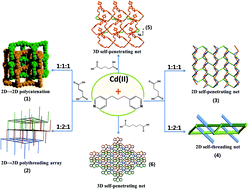Tuning different kinds of entangled metal–organic frameworks by modifying the spacer group of aliphatic dicarboxylate ligands and the reactant ratio†
Abstract
Taking advantage of the conformational flexibility of the bpp ligand and aliphatic dicarboxylic acids, six interesting entangled coordination polymers, {[Cd(fum)(bpp)(H2O)]·(H2O)}n (1), {[Cd(fum)(bpp)2]·(H2O)5}n (2), {[Cd2(suc)1.5(bpp)2(NO3)(H2O)2]·6H2O}n (3), {[Cd(suc)(bpp)2]·(H2O)1.5}n (4), {[Cd2(glu)2(bpp)3]·10H2O}n (5), and {Cd(adp)(bpp)(H2O)}n (6) have been prepared and structurally characterized (bpp = 1,3-bi(4-pyridyl)propane, fum = fumaric, suc = succinate, glu = glutaric, adp = adipic). Compounds 1 and 2 are comprised of undulated 2D 44-sql networks. In the structure of compound 1, two identical undulated layers are parallelly interpenetrated with each other to give a 2D → 2D interpenetrating framework. For 2, the dangling arms projected from 2D layers are intercalated into the neighboring sheets, producing a 2D → 3D polythreading framework. Compound 3 shows a rare example of a 2D self-penetrating framework with a (3,4)-connected (42·63·8)(42·6) topology. Compound 4 presents an unusual 2D self-threading network with a novel 4-connected {42·63·8} topology. Compound 5 displays a 3D self-penetrating system based on a 2D → 3D parallel polycatenation array. Compound 6 exhibits an unprecedented 3D self-penetrating structure having both 1D + 1D → 1D polycatenation and 3D + 3D → 3D interpenetration characteristics. A comparison of these six compounds demonstrates that both the different spacer lengths of the aliphatic dicarboxylates and reactant ratios appear to play a significant role in the assembly of entangled frameworks. In addition, thermal stabilities and photoluminescence properties of 1–6 have been examined in the solid state at room temperature.


 Please wait while we load your content...
Please wait while we load your content...